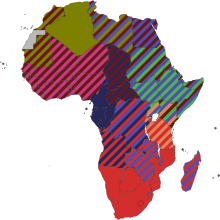Economy

Map of the African Economic Community.

NASA image acquired April 18 – October 23, 2012..This new image of the Earth at night is a composite assembled from data acquired by the Suomi National Polar-orbiting Partnership (Suomi NPP) satellite over nine days in April 2012 and thirteen days in October 2012. It took 312 orbits and 2.5 terabytes of data to get a clear shot of every parcel of Earth’s land surface and islands…The nighttime view of Earth in visible light was made possible by the “day-night band” of the Visible Infrared Imaging Radiometer Suite. VIIRS detects light in a range of wavelengths from green to near-infrared and uses filtering techniques to observe dim signals such as gas flares, auroras, wildfires, city lights, and reflected moonlight. In this case, auroras, fires, and other stray light have been removed to emphasize the city lights…Named for satellite meteorology pioneer Verner Suomi, NPP flies over any given point on Earth’s surface twice each day at roughly 1:30 a.m. and 1:30 p.m. The spacecraft flies 824 kilometers (512 miles) above the surface in a polar orbit, circling the planet about 14 times a day. Suomi NPP sends its data once per orbit to a ground station in Svalbard, Norway, and continuously to local direct broadcast users distributed around the world. The mission is managed by NASA with operational support from NOAA and its Joint Polar Satellite System, which manages the satellite’s ground system…NASA Earth Observatory image by Robert Simmon, using Suomi NPP VIIRS data provided courtesy of Chris Elvidge (NOAA National Geophysical Data Center). Suomi NPP is the result of a partnership between NASA, NOAA, and the Department of Defense. Caption by Mike Carlowicz…Instrument: Suomi NPP – VIIRS ..Credit: NASA Earth Observatory..Click here to view all of the Earth at Night 2012 images ..Click here to read more about this image …NASA image use policy...NASA Goddard Space Flight Center enables NASA’s mission through four scientific endeavors: Earth Science, Heliophysics, Solar System Exploration, and Astrophysics. Goddard plays a leading role in NASA’s accomplishments by contributing compelling scientific knowledge to advance the Agency’s mission…Follow us on Twitter..Like us on Facebook..Find us on Instagram
Satellite image of city lights in Africa showing the relatively low modern development on the continent in 2012 as compared to Eurasia.
Main articles: Economy of Africa, List of African countries by GDP (nominal), and List of African countries by GDP (PPP)
See also: Economy of the African Union
| Rank | Country | GDP (PPP, Peak Year) millions of USD |
Peak Year |
| 1 | Egypt | 1,427,432 | 2020 |
| 2 | Nigeria | 1,215,389 | 2019 |
| 3 | South Africa | 804,688 | 2019 |
| 4 | Algeria | 668,827 | 2019 |
| 5 | Morocco | 327,251 | 2019 |
| 6 | Ethiopia | 253,102 | 2020 |
| 7 | Libya | 220,503 | 2007 |
| 8 | Ghana | 209,179 | 2020 |
| 9 | Angola | 200,830 | 2019 |
| 10 | Tanzania | 198,652 | 2020 |
| Rank | Country | GDP (nominal, Peak Year) millions of USD |
Peak Year |
| 1 | Nigeria | 568,496 | 2014 |
| 2 | South Africa | 416,879 | 2011 |
| 3 | Egypt | 353,003 | 2020 |
| 4 | Algeria | 213,810 | 2014 |
| 5 | Angola | 145,712 | 2014 |
| 6 | Morocco | 124,539 | 2020 |
| 7 | Kenya | 109,128 | 2020 |
| 8 | Ethiopia | 103,607 | 2020 |
| 9 | Libya | 79,759 | 2012 |
| 10 | Ghana | 72,037 | 1982 |
Although it has abundant natural resources, Africa remains the world’s poorest and least-developed continent, the result of a variety of causes that may include corrupt governments that have often committed serious human rights violations, failed central planning, high levels of illiteracy, lack of access to foreign capital, and frequent tribal and military conflict (ranging from guerrilla warfare to genocide).[135] Its total nominal GDP remains behind that of the United States, China, Japan, Germany, the United Kingdom, India and France. According to the United Nations‘ Human Development Report in 2003, the bottom 24 ranked nations (151st to 175th) were all African.
Poverty, illiteracy, malnutrition and inadequate water supply and sanitation, as well as poor health, affect a large proportion of the people who reside in the African continent. In August 2008, the World Bank[137] announced revised global poverty estimates based on a new international poverty line of $1.25 per day (versus the previous measure of $1.00). 81% of the Sub-Saharan Africa population was living on less than $2.50 (PPP) per day in 2005, compared with 86% for India.
Sub-Saharan Africa is the least successful region of the world in reducing poverty ($1.25 per day); some 50% of the population living in poverty in 1981 (200 million people), a figure that rose to 58% in 1996 before dropping to 50% in 2005 (380 million people). The average poor person in sub-Saharan Africa is estimated to live on only 70 cents per day, and was poorer in 2003 than in 1973 indicating increasing poverty in some areas. Some of it is attributed to unsuccessful economic liberalization programmes spearheaded by foreign companies and governments, but other studies have cited bad domestic government policies more than external factors.
Africa is now at risk of being in debt once again, particularly in Sub-Saharan African countries. The last debt crisis in 2005 was resolved with help from the heavily indebted poor countries scheme (HIPC). The HIPC resulted in some positive and negative effects on the economy in Africa. About ten years after the 2005 debt crisis in Sub-Saharan Africa was resolved, Zambia fell back into debt. A small reason was due to the fall in copper prices in 2011, but the bigger reason was that a large amount of the money Zambia borrowed was wasted or pocketed by the elite.[143]
From 1995 to 2005, Africa’s rate of economic growth increased, averaging 5% in 2005. Some countries experienced still higher growth rates, notably Angola, Sudan and Equatorial Guinea, all of which had recently begun extracting their petroleum reserves or had expanded their oil extraction capacity.
In a recently published analysis based on World Values Survey data, the Austrian political scientist Arno Tausch maintained that several African countries, most notably Ghana, perform quite well on scales of mass support for democracy and the market economy.[144]
Tausch’s global value comparison based on the World Values Survey derived the following factor analytical scales: 1. The non-violent and law-abiding society 2. Democracy movement 3. Climate of personal non-violence 4. Trust in institutions 5. Happiness, good health 6. No redistributive religious fundamentalism 7. Accepting the market 8. Feminism 9. Involvement in politics 10. Optimism and engagement 11. No welfare mentality, acceptancy of the Calvinist work ethics.
The spread in the performance of African countries with complete data, Tausch concluded “is really amazing”. While one should be especially hopeful about the development of future democracy and the market economy in Ghana, the article suggests pessimistic tendencies for Egypt and Algeria, and especially for Africa’s leading economy, South Africa. High Human Inequality, as measured by the UNDP‘s Human Development Report‘s Index of Human Inequality, further impairs the development of Human Security. Tausch also maintains that the certain recent optimism, corresponding to economic and human rights data, emerging from Africa, is reflected in the development of a civil society.
The continent is believed to hold 90% of the world’s cobalt, 90% of its platinum, 50% of its gold, 98% of its chromium, 70% of its tantalite,[145] 64% of its manganese and one-third of its uranium.[146] The Democratic Republic of the Congo (DRC) has 70% of the world’s coltan, a mineral used in the production of tantalum capacitors for electronic devices such as cell phones. The DRC also has more than 30% of the world’s diamond reserves.[147] Guinea is the world’s largest exporter of bauxite.[148] As the growth in Africa has been driven mainly by services and not manufacturing or agriculture, it has been growth without jobs and without reduction in poverty levels. In fact, the food security crisis of 2008 which took place on the heels of the global financial crisis pushed 100 million people into food insecurity.[149]
In recent years, the People’s Republic of China has built increasingly stronger ties with African nations and is Africa’s largest trading partner. In 2007, Chinese companies invested a total of US$1 billion in Africa.[100]
A Harvard University study led by professor Calestous Juma showed that Africa could feed itself by making the transition from importer to self-sufficiency. “African agriculture is at the crossroads; we have come to the end of a century of policies that favoured Africa’s export of raw materials and importation of food. Africa is starting to focus on agricultural innovation as its new engine for regional trade and prosperity.”
During US President Barack Obama’s visit to Africa in July 2013, he announced a US$7 billion plan to further develop infrastructure and work more intensively with African heads of state. He also announced a new programme named Trade Africa, designed to boost trade within the continent as well as between Africa and the US.[151]
